Teacher Questions in Turkish EFL Classrooms: A Qualitative Study
Teacher Questions in Turkish EFL Classrooms: A Qualitative Study
The purpose of this study is to analyze how teacher questions were formed and how they are posed depending on their functions in Turkish EFL (English as a foreign language) classrooms. In the current study, the types of teacher questions were classified according to Farrell’s taxonomy involving two main categories entitled as echoic and epistemic along with seven divergent sub-categories named as comprehension checks, clarification requests, confirmation checks, referential, display, expressive and rhetorical. Three EFL teachers’ different types of online EFL lessons such as grammar, reading, listening and speaking were recorded online for data collection. All recordings were turned into written transcripts for data analysis. The transcribed data was analyzed by the content analysis according to Farrell’s taxonomy, which was developed from Ellis (1994), regarding teacher questions. Samples of transcribed lessons were examined by the researcher and the data was qualitatively analyzed accordingly. The findings of the current study revealed that display and referential questions were used more often by the participant EFL teachers among all teacher question types. Although there was a resemblance with previous research regarding the most frequent teacher question types in general, the preference of question types differed from each other when each teacher’s video recordings analyzed separately. In addition, it can also be stated that teachers tended to favor the comprehension check questions intermittently in the instructional phase of lessons by reason of assuring that students perceived what they intended to deliver. The details are further discussed and the implications are made in the article.
Keywords:
Teacher Questions, Students’ Participation, Classroom Interaction English Language Teaching (ELT),
___
- Barnes, D. (1976). From communication to curriculum. Middlesex, UK: Penguin.
- Barnett, J. E., & Francis, A. L. (2012). Using higher order thinking questions to foster critical thinking: a classroom study. An International Journal of Experimental Educational Psychology, 32(2), 201–211.
- Brock, C. A. (1986). The effects of referential questions on ESL classroom discourse. TESOL Quarterly, 20, 77–59.
- Brophy, J. E., & Good, T. L. (1991). Looking in classrooms (5th ed.). New York: HarperCollins.
- Cullen, R. (1998). Teacher talk and the classroom context. ELT journal, 52(3), 179-187.
- Darong, H. C., & Niman, E. M. (2021). Do teacher questions function as assessment for learning?. Randwick International of Education and Linguistics Science Journal, 2(3), 437-454.
- Ellis, R. (1994). Second language acquisition research and teacher development: The case of teachers’ questions. In D. Li, D. Mahony, & J. Richards (Eds.), Exploring second language teacher development (pp. 175–194). Hong Kong: City University.
- Farrell, T.S.C. (2009). Talking, listening and teaching: A guide to classroom communication. Thousand Oaks, CA: Corwin Press.
- Farrell, T.S.C. & Mom, V. (2015). Exploring teacher questions through reflective practice. Reflective Practice, 16(6), 849-865. Doi: 10.1080/14623943.2015.1095734
- Hendricks, M. (2003). Classroom talk:" there are more questions than answers". Southern African Linguistics and Applied Language Studies, 21(1-2), 29-40. Doi: 10.2989/16073610309486326
- Kılınç, G. Çalışkan H. (2019). How and with what frequency do social studies teachers ask questions? Journal of Bartın University Education Faculty, 8 (2), 562-589. Doi: 10.14686/buefad.465630
- Lee, J., & Kim, K. (2016). Pre-service teachers’ conceptions of effective teacher talk: their critical reflections on a sample teacher-student dialogue. Educational Studies in Mathematics, 93(3), 363–381. Doi: 10.1007/s10649-016-9710-y
- Long, M. H. & Sato, C. J. (1983). Classroom foreigner talk discourse: Forms and functions of teachers’ questions. In H. W. Seliger & M. H. Long (Eds.), Classroom oriented research in second language acquisition (pp. 3–34). Rowley, MA: Newbury House.
- Maphosa, C., & Wadesango, N. (2017). Questioning ‘questioning’: examining the use of questioning as an interactive teaching tool in higher education. Journal of Communication, 7(1), 111–117. Doi: 10.1080/0976691X.2016.11884889
- Nguyễn, T. U. (2019). Exploring the reflective practice of TESOL novice and student teachers: A Case Study. Retrieved from http://repository.ulis.vnu.edu.vn/bitstream/ULIS_123456789/2145/1/E.KL.GHP.817.pdf
- Stivers, T. (2018). How we manage social relationships through answers to questions: the case of interjections. Discourse Processes. Doi: 10.1080/0163853X.2018.1441214
- Tavakoli, E. & Davoudi, M. (2016). Question generation behavior of reflective teachers, Reflective Practice. Routledge. 7(4), 415-429. Doi: 10.1080/14623943.2016.1169167
- Başlangıç: 2021
- Yayıncı: Selçuk Üniversitesi
Sayıdaki Diğer Makaleler
Translation Today: Audiovisual Translation in Focus
İNGİLİZCEDE VE AZERBAYCAN TÜRKÇESİNDE ŞİİRSEL METİNLERDE BENZER KAVRAMLARA DAYALI METAFORLAR
Çeviri Eğitiminde Süreç Odaklı Yaklaşım
Treating cultural references in translation: The Wedding of Zein as an example
ETHICAL PROBLEMS IN TRANSLATED LITERARY WORKS: PLAGIARISM
Teacher Questions in Turkish EFL Classrooms: A Qualitative Study
